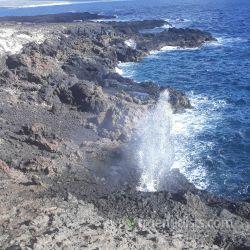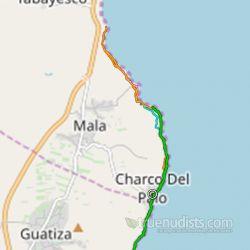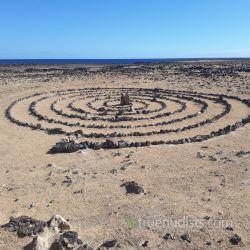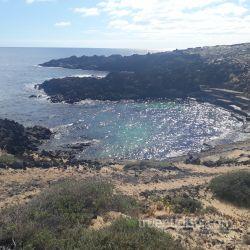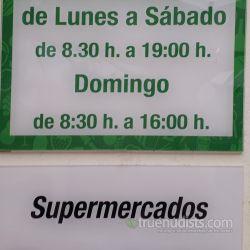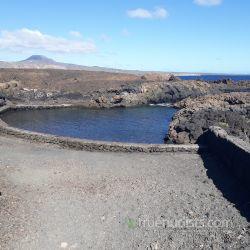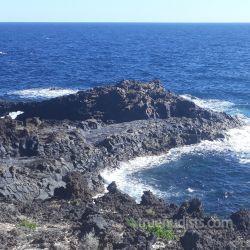Lanzarote-Charco Del Palo
It is a group for all friends of Lanzarote- nudist village Charco del Palo
Review of CDP
Return to DiscussionsSeveral people gave me some good advice about CDP last year for which many thanks. I had a great time there and hope to go again sometime. I wrote a review but got involved in other things so here it is now, albeit rather late:
Review of Charco del Palo
Charco del Palo is a small naturist village in the north east of Lanzarote of about 150 inhabitants with a large number of holiday lets available. The village was founded by a German entrepreneur and most visitors are German but it is popular with British naturists as well as Dutch and Norwegians. It is served by Arecife airport about a 17mile drive away.
I stayed in Charco Del Palo for 10 days in January 2019. The average temperature for Charco in January is 21/14C which is slightly better than I got. Mostly the weather was partly cloudly, except for the Saturday when it was heavily overcast all day and only made 19C at best. However this was warm enough for me to be out and about unclad almost every day and it was warm enough and sunny enough to swim and then dry out without using a towel (Im English and 19C is quite warm for me!). Lanzarote lies in the trade winds which come down from the North and then cross the Atlantic further South, and the wind was Northerly all the time I was there so on a bad day the wind did feel quite cool.
The local supermarket is open every day from 8:30pm but shuts early on Sundays. It has a wide range of stock but, like a convenience store in the UK, the choice of brand is for each item is limited. I bought my supplies in the Eurospar in Arecife but I could have bought all the same stuff in Charco but it would have cost a little more. Clothing is compulsory in the supermarket.
There are a number of Bars and cafes, most open in the evenings and the only one I saw open at lunch time was the one at Obona. But I wasnt really looking, and there may have been others. In the Commercial Centre there is Lilis bar which opens from 5pm and it seems you can go naked in the outside portion but of course you might find it a bit chilly in the evening.
Charco has three places for swimming and there is another natural pool about 2 miles to the north near Vaya Querida. The main pool is a natural basin with a wall to the seaward and this retains a good depth at all states of the tide and there is plenty of space to sunbath either on sand or rock. On the north side there is a railing to help you get in as the bottom can be very slippery, from the end of the rail to the other side is about 20 metres so you can swim lengths with ease. Of course the temperature is set by the incoming water from the sea which is 19C in January dropping to 18 in February and rising again to a peak of 23 in September and October, so the most lengths I did was 36 before beginning to feel the chill in my core.
A little to the south of the main pool is a promontory with a couple of ladders into the sea on the south side. At high tide the tops of the ladders can be covered and the waves quite strong but at lower tides this is an excellent place to swim. Strangely the water here felt slightly warmer than in the pool. From the promontory to the rocks on the south side of the bay is about 40 meters and to the east the next stop is Africa, so plenty of scope for swimming. There are two ladders, the inner one stops on a ledge but the outer one goes deeper, I recommend using the inner one as it has round rungs which dont seem to get as slippery as the square rungs of the outer ladder. A number of people here were using snorkels and masks and on one day there was a Scuba school swimming there so there must be something to look at under the surface. The promontory protects the swimming area from the sea in the north wind but, I suspect, it could get quite rough in an easterly.
The third place for swimming in Charco is the smaller southern pool and this is a natural pool as there is no wall to the seaward side. Unfortunately this means it is a little shallow at low water, but at high water it is plenty deep enough and you can get a bit of a swell coming in. Straight across this has a length of about 15 metres but as it is close to circular you can get nearly 40 metres swimming around the edge. However be careful near the entrance from the sea as there are some sharp rocks which will be just below the surface at various states of the tide, I know because I cut my knee doing breast stroke near the entrance.
I didnt try the northern pool near Vaya Querida, it looked shallow at low tide but quite good at high tide. There are also a number of places you can get into the sea from the rocks, but I cant recommend that as the rocks are sharp and the waves can be strong, I did however see some people going in off the rocks to the north.
I think one of the best features of Charco is that you are not constrained to the village and you can walk the coastal path and area to the north without having to cover up. I walked almost every day, the furthest I went north was just over 3 miles to the bay south of Arrieta. I only stopped then because I came up to a collection of shanty huts with some loud and aggressive dogs, I could have gone round and perhaps got almost all the way to Arrieta. To the south the furthest I went was 1 mile until I came up to a hotel (Buen Retiro). The area to the north is fairly flat and there are many paths to wander on, in the short time I was there I tended to stick close to the sea. To the south the paths are more limited but the scenery more dramatic, and a bit more challenging. I say you can walk these paths freely but I was stopped on one day by a German Lady who explained to me in no uncertain terms that I could only go naked in the confines of the village and if the police saw me I would be fined 200 Euros. However I contacted British Naturism and Sharmaine there put me in touch with the Federacin Espaola de Naturismo who explained that there is no law stopping nudism in public spaces in Spain, and if I were arrested I would be released very quickly.
Along the coast are many rock sculptures, mostly stone circles or spirals but I also saw hearts, anchors and other shapes that I couldnt make out. One particularly good spiral had what looked like a newly married couple in the middle. There are also a number of shelters make by piling lava rocks into circular or rectangular dry stone walls about 2 feet tall, these appear to be popular for sun bathing and barbeques.
While out walking I always wore sandals, but there were two problems that I found. First the sand is mixed with lava gravel pieces which can be quite sharp and with sandals these find their way between sole and foot. Forewarned, I had taken my Sketchers sandals which have a soft inner sole and so it was only the bigger particles which caused me any issue. But the outer soles of the Sketchers are also soft and a lot if the time I was walking on lava rocks which have cut the soles of the sandals quite badly, I could have taken my Merrels which have a Vibram sole but a hard inner sole, so most people would probably be more sensible than me and wear trainers or walking boots.
Lanzarote is a volcanic island and this leads to some interesting if stark scenery. Quite a common feature is the formation of large circular holes, like those which form the swimming pools and some of the bays in Charco. These appear to be flue holes from the eruptions and the sides often look as though someone has poured black treacle down the sides, which is, of course, pretty much what happened but it was molten rock not treacle. There is a lovely example of one of these to the south near the Buen Retiro hotel which at high tide is full of water but at low tide you can see a hole through to the sea. Another feature of the geology is blow holes and there are a number of these along the coast to the north, particularly to the south of Punta Pasito. These throw spouts of water into the air when the waves and tide are just right, and some go quite high. Not all of them are wet though and I found one dry one near La Hondura. The clue to its existence was a sound like a sick cow which I assumed was from the coast, but when I went to investigate the noise was behind me and inland a bit. After some looking I found a small depression filled with small rocks from where the noise was coming. What surprised me, which I discovered by placing paper on top of it, was that the noise was made not by the blow but by the sucking as the wave below retreated.
The final note I want to make is about tourists, because while I was there quite a large number of people came into the village just to look. Now I dont know if they came because they were just looking at all the villages and coast in Lanzarote or whether they wanted to see what a nudist paradise was like, but they came with their cameras and phones to take pictures. Most were couples but sometimes they were in larger groups. One group was about a dozen with 4 adults and the rest small children, I suspect they didnt realise what Charco was like but it means that even in a naturist village you need to carry something you can wrap around you in case of the unexpected.
The delights of Charco Del Palo for me lie in the fact that it is not bounded in the way some naturist resorts are. There is no sign at the edge of the village saying Textile land ahead Cover up. While it would be better if we could going shopping in the nude and the nights were warm enough to stay naked throughout, the freedom of being to just be in nature without a territorial limit is a big draw.

